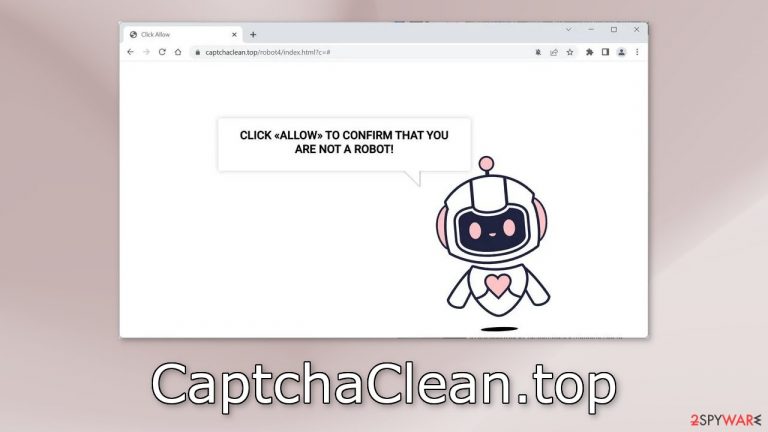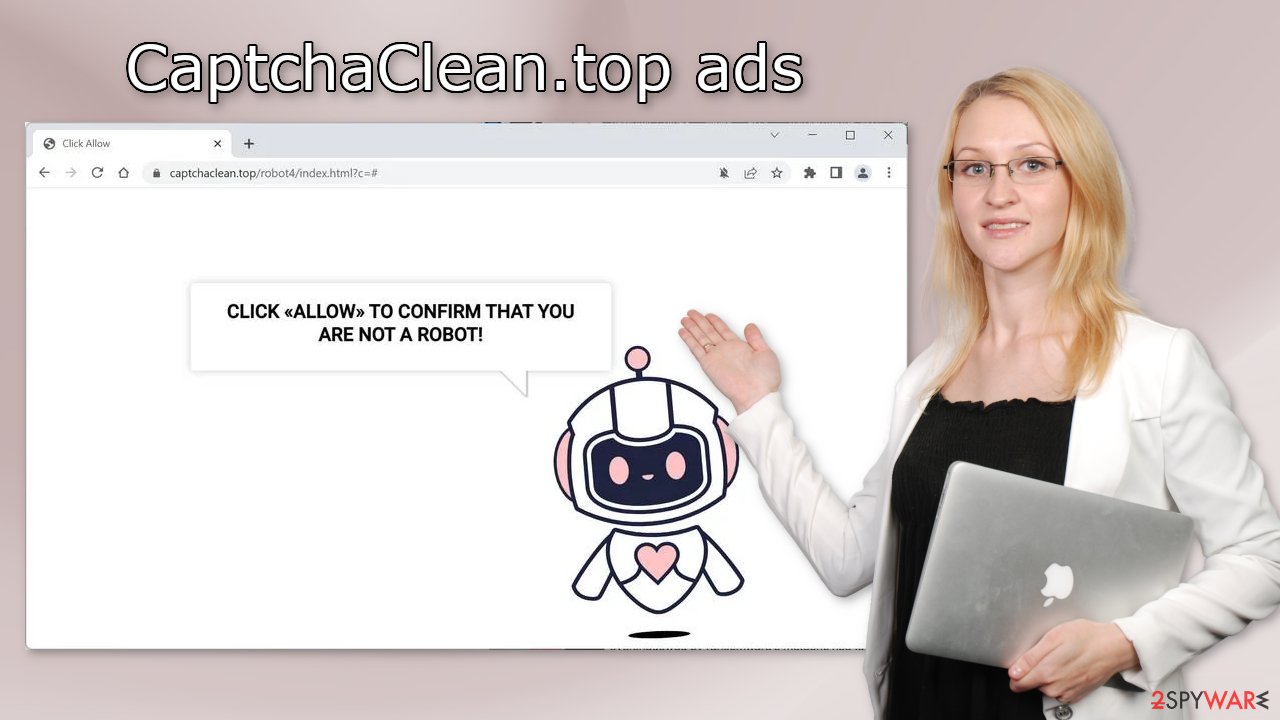CaptchaClean.top ads (spam) - Free Guide
CaptchaClean.top ads Removal Guide
What is CaptchaClean.top ads?
CaptchaClean.top can cause your screen to fill up with annoying pop-up ads

CaptchaClean.top is a bogus website that pretends to be a human verification step. It asks users to press the “Allow” button to confirm that they are not robots. Instead, users subscribe to push notifications. Such manipulation tactics are known as social engineering.[1]
The main purpose of the page is to generate revenue from pay-per-click advertising. Unfortunately, crooks may also be using rogue advertising networks[2] that place ads leading to dangerous websites. Users may end up on pages that try to trick them into providing personal information, downloading PUPs (potentially unwanted programs),[3] and even malware.
| NAME | CaptchaClean.top |
| TYPE | Push notification spam; adware |
| SYMPTOMS | Pop-up ads start appearing in the corner of the screen unexpectedly, sometimes even when the browser is closed |
| DISTRIBUTION | Shady websites; deceptive ads; freeware installations |
| DANGERS | The pop-ups can contain links leading to websites from rogue advertising networks |
| ELIMINATION | Go to your browser settings to disable browser permissions |
| FURTHER STEPS | Use FortectIntego to fix any remaining damage and clear your browsers |
Distribution methods
Sites like CaptchaClean.top rarely appear in the search results. Usually, they hide in other shady sites that are unregulated. For example, illegal streaming sites[4] are full of deceptive ads, sneaky redirects, fake “Download” and “Play” buttons.[5] They can open new tabs with harmful pages.
It is best to only visit websites that you know and trust. Use legitimate streaming services because they do not pose any danger. Do not click on random links and advertisements. Even if it seems to be promoting legitimate products or services, go directly to the source instead of through an ad.
Another possibility is that the deceptive page appeared without any user input. This can happen if there is adware hiding in your machine. It can cause an increased amount of commercial content, like pop-ups, banners, and redirects. Most often, it ends up on the system through freeware installations.

Stop the intrusive pop-ups
Below you will find a manual guide on how to take care of your browser. Because push notifications are subscription-based, you will have to disable them yourself:
Google Chrome (desktop):
- Open Google Chrome browser and go to Menu > Settings.
- Scroll down and click on Advanced.
- Locate the Privacy and security section and pick Site Settings > Notifications.

- Look at the Allow section and look for a suspicious URL.
- Click the three vertical dots next to it and pick Block. This should remove unwanted notifications from Google Chrome.

Google Chrome (Android):
- Open Google Chrome and tap on Settings (three vertical dots).
- Select Notifications.
- Scroll down to Sites section.
- Locate the unwanted URL and toggle the button to the left (Off setting).

Mozilla Firefox:
- Open Mozilla Firefox and go to Menu > Options.
- Click on Privacy & Security section.
- Under Permissions, you should be able to see Notifications. Click Settings button next to it.

- In the Settings – Notification Permissions window, click on the drop-down menu by the URL in question.
- Select Block and then click on Save Changes. This should remove unwanted notifications from Mozilla Firefox.

Safari:
- Click on Safari > Preferences…
- Go to Websites tab and, under General, select Notifications.
- Select the web address in question, click the drop-down menu and select Deny.

MS Edge:
- Open Microsoft Edge, and click the Settings and more button (three horizontal dots) at the top-right of the window.
- Select Settings and then go to Advanced.
- Under Website permissions, pick Manage permissions and select the URL in question.

- Toggle the switch to the left to turn notifications off on Microsoft Edge.
MS Edge (Chromium):
- Open Microsoft Edge, and go to Settings.
- Select Site permissions.
- Go to Notifications on the right.
- Under Allow, you will find the unwanted entry.
- Click on More actions and select Block.

Cookies and cache
If blocking ads via browser settings worked for you, now you should take care of your browser by clearing cookies and cache. They are used by almost every website to track your activity. They can store data like your IP address, geolocation, websites you visit, and things you purchase online.
This data can later be sold to advertising networks or other third parties. That is why security experts recommend clearing browsers regularly. We also have an automatic solution for this if you want to avoid a lengthy manual process – FortectIntego. This powerful software can also fix various system errors, corrupted files, and registry issues which is especially helpful after a virus infection.
Remove adware from your system
If you completed the previous steps but you still experience unwanted symptoms, like an increased amount of commercial content, pop-ups, banners, and redirects you should check your system for an adware infection. It is an advertising-supported software that can generate advertisements on the machine without the users' consent or knowledge.
Most commonly, people infect themselves with adware by installing programs from freeware distribution platforms. They include additional apps in the installers and disguise them as “handy” tools. Many users skip through the installation process so they do not notice.
You should always choose the “Custom” or “Advanced” installation methods, read the Privacy Policy and Terms of Use. The most important step is to check the file list and untick the boxes next to any unrelated applications. And if you really want to keep your device safe, use only official web stores and developer websites whenever you want to install software.
Because it is unclear which app could be causing the problems, we suggest using SpyHunter 5Combo Cleaner or Malwarebytes anti-malware tools that can automatically scan your machine and eliminate it completely. Security software can also warn you before a malicious program can make any changes.
However, if you still want to do it yourself, here are the directions for Windows and macOS systems:
Windows 10/8:
- Enter Control Panel into Windows search box and hit Enter or click on the search result.
- Under Programs, select Uninstall a program.

- From the list, find the entry of the suspicious program.
- Right-click on the application and select Uninstall.
- If User Account Control shows up, click Yes.
- Wait till uninstallation process is complete and click OK.

Windows 7/XP:
- Click on Windows Start > Control Panel located on the right pane (if you are Windows XP user, click on Add/Remove Programs).
- In Control Panel, select Programs > Uninstall a program.

- Pick the unwanted application by clicking on it once.
- At the top, click Uninstall/Change.
- In the confirmation prompt, pick Yes.
- Click OK once the removal process is finished.
Mac:
- From the menu bar, select Go > Applications.
- In the Applications folder, look for all related entries.
- Click on the app and drag it to Trash (or right-click and pick Move to Trash)

To entirely remove an unwanted app, you need to access Application Support, LaunchAgents, and LaunchDaemons folders and delete relevant files:
- Select Go > Go to Folder.
- Enter /Library/Application Support and click Go or press Enter.
- In the Application Support folder, look for any suspicious entries and then delete them.
- Now enter /Library/LaunchAgents and /Library/LaunchDaemons folders the same way and terminate all the related .plist files.

How to prevent from getting adware
Do not let government spy on you
The government has many issues in regards to tracking users' data and spying on citizens, so you should take this into consideration and learn more about shady information gathering practices. Avoid any unwanted government tracking or spying by going totally anonymous on the internet.
You can choose a different location when you go online and access any material you want without particular content restrictions. You can easily enjoy internet connection without any risks of being hacked by using Private Internet Access VPN.
Control the information that can be accessed by government any other unwanted party and surf online without being spied on. Even if you are not involved in illegal activities or trust your selection of services, platforms, be suspicious for your own security and take precautionary measures by using the VPN service.
Backup files for the later use, in case of the malware attack
Computer users can suffer from data losses due to cyber infections or their own faulty doings. Ransomware can encrypt and hold files hostage, while unforeseen power cuts might cause a loss of important documents. If you have proper up-to-date backups, you can easily recover after such an incident and get back to work. It is also equally important to update backups on a regular basis so that the newest information remains intact – you can set this process to be performed automatically.
When you have the previous version of every important document or project you can avoid frustration and breakdowns. It comes in handy when malware strikes out of nowhere. Use Data Recovery Pro for the data restoration process.
- ^ Social Engineering. Imperva. Learning Center.
- ^ Zeljka Zorz. How does a rogue ad network function?. Helpnetsecurity. Information Security Blog.
- ^ Chris Hoffman. PUPs Explained: What is a “Potentially Unwanted Program”?. Howtogeek. Technology Magazine.
- ^ Brittni Devlin. Why Should You Avoid Illegal Streaming Sites?. Makeuseof. Technology Blog.
- ^ Andy Maxwell. Google Targets Fake ‘Download’ and ‘Play’ Buttons. Torrentfreak. Filesharing News.
